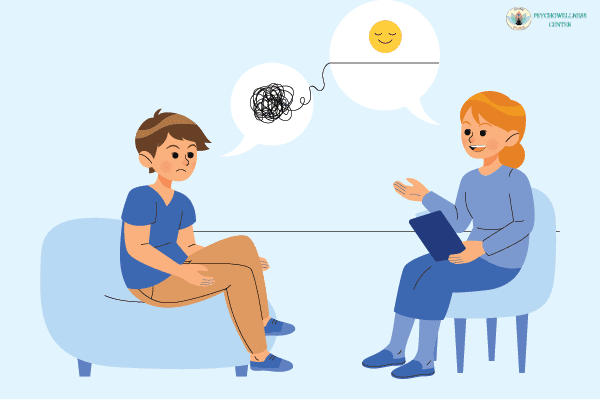A Guide for Parents on Understanding and Recognizing OCD in Child and Teens

Obsessive-Compulsive Disorder (OCD) is a mental health condition that affects people of all ages, including children and teenagers. It's important for parents to understand what OCD is and isn't, recognize its symptoms, and know how to find help for their child if needed. In this article, we'll delve into these aspects of OCD in children and teens, as well as explore ways to create a supportive environment for them.
Understanding OCD
OCD is often misunderstood as simply being overly neat or organized, but it's much more complex than that. It involves experiencing intrusive thoughts, images, or urges (obsessions) that lead to repetitive behaviors or mental acts (compulsions) aimed at reducing distress or preventing a dreaded event. These obsessions and compulsions can significantly interfere with daily life and cause distress.
It's crucial to recognize that OCD is not a personality quirk or a choice. It's a neurobiological condition, likely influenced by a combination of genetic, neurological, behavioral, cognitive, and environmental factors. Children and teens with OCD are not intentionally behaving this way, but rather, they are struggling with a mental health issue that requires understanding and support.
OCD Symptoms in Children and Teens
OCD symptoms can manifest differently in children and teens compared to adults. They may not always recognize their thoughts or behaviors as irrational or excessive, and they may feel embarrassed or ashamed to talk about them. Common obsessions and compulsions in children and teens may include:
Obsessions: Fear of contamination, fears of harm coming to themselves or loved ones, unwanted sexual thoughts or images, religious or moral obsessions, and fears of making a mistake.
Compulsions: Excessive handwashing, repetitive checking (such as checking locks or appliances), counting, arranging items in a specific way, seeking reassurance, and mental rituals (such as repeating phrases or prayers).
It's essential for parents to pay attention to any unusual behaviors or signs of distress in their child, especially if these behaviors interfere with their daily functioning or cause significant distress.
Finding Help for Your Child with OCD
If you suspect that your child may have OCD, seeking professional help is crucial. Start by talking to your child's pediatrician or a mental health professional experienced in working with children and adolescents. They can conduct a thorough evaluation to determine whether your child's symptoms are consistent with OCD or another condition.
Generally, OCD is diagnosed when obsessions and compulsions consume a significant amount of time (usually more than an hour a day) and cause distress or impair functioning. However, diagnosis in children and teens can be challenging due to their limited ability to articulate their experiences or recognize that their thoughts or behaviors are excessive or irrational.
How OCD is Treated in Children and Teens
Fortunately, OCD is a treatable condition, and early intervention can lead to better outcomes. The primary treatments for OCD in children and teens include:
Cognitive-Behavioral Therapy (CBT): Specifically, a type of CBT called Exposure and Response Prevention (ERP) is highly effective for treating OCD. ERP involves gradually exposing the child to their feared thoughts or situations while preventing the usual compulsive response, helping them learn to tolerate discomfort and reduce the urge to engage in compulsions.
Medication: In some cases, medication, such as selective serotonin reuptake inhibitors (SSRIs), may be prescribed to help manage OCD symptoms. It's essential to work closely with a psychiatrist experienced in treating children and teens to find the right medication and dosage.
Family Therapy: Involving the family in treatment can be beneficial for both the child with OCD and their parents or caregivers. Family therapy can help educate family members about OCD, improve communication, and teach strategies for supporting the child's recovery. Creating a Supportive Environment for Kids with OCD. Family support plays a crucial role in helping children and teens manage OCD.
Here are some things family members can do to create a supportive environment:
Educate Yourself: Learn as much as you can about OCD, including its causes, symptoms, and treatments. Understanding the condition can help you provide better support to your child.
Be Patient and Understanding: It's essential to be patient with your child and avoid criticizing or minimizing their symptoms. Offer reassurance and support without enabling their compulsions.
Encourage Treatment Adherence: Encourage your child to participate in therapy and take any prescribed medications as directed. Offer praise and encouragement for their efforts in managing their symptoms.
Create a Low-Stress Environment: Try to minimize stressors in your child's environment and provide opportunities for relaxation and self-care.
Communicate Openly: Encourage your child to talk about their feelings and experiences related to OCD. Listen non-judgmentally and offer empathy and support.
Model Healthy Coping Strategies: Demonstrate healthy coping strategies for managing stress and anxiety, such as deep breathing exercises, mindfulness, and problem-solving skills.
In conclusion, OCD is a challenging but treatable condition that can affect children and teens. By understanding the nature of OCD, recognizing its symptoms, seeking appropriate help, and creating a supportive environment, parents can help their child effectively manage their symptoms and improve their quality of life. If you suspect that your child may have OCD, don't hesitate to reach out to a mental health professional for guidance and support.
Related Stories

Social Distancing And Coronavirus: How To Cope With Loneliness

Make The Most Out Of Online Counselling


SHARE